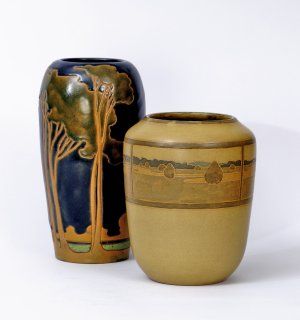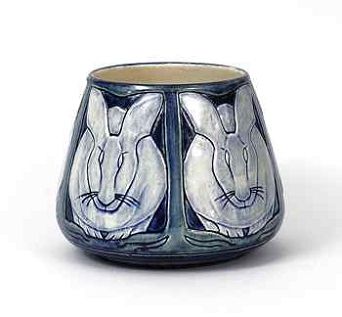Beauty in Common Things: American Arts & Crafts Pottery
Exhibition dates: October 4, 2008-February 15, 2009
October 4, 2008
This exhibition features approximately 80 superb examples of pottery from the American Arts and Crafts movement by such esteemed potteries as Rookwood, Grueby, Newcomb College, Marblehead, Teco, Saturday Evening Girls, and Overbeck. Furniture and paintings will place the ceramic objects in context and create environments that will enhance understanding of the Arts and Crafts movement in America.

The quiet strength and dignity of the mat-glazed Grueby vases is matched by the richly grained oak furniture of Gustav Stickley. The gentle color combinations and Japanese-inspired decoration on the work of the Marblehead Potteries find their counterpoint in the exquisitely painted furniture of the Byrdcliffe Colony. All the works are on loan from the Two Red Roses Foundation, one of this country's most important private collections of Arts and Crafts objects.
Reacting against the crassness of industrial production and seeking to elevate the decorative arts to the level of the fine arts, fervent Arts and Crafts reformers advocated the reintegration of art into everyday life. The implications were both social and aesthetic, and touched upon critical issues such as the role of women in society and the search for a modern style. This exhibition is curated by Dr. Martin Eidelberg, Professor Emeritus of Art History at Rutgers University, and Dr. Jonathan Clancy of the Sotheby's Institute of Art.

Museum Director Dr. John Schloder writes in the introduction to the catalogue that "this exhibition and its accompanying catalogue explore the ceramics of this transformative, turn-of-the-century movement. Most of the great ceramic producers are represented with artful works that people lovingly used in their homes and in their everyday life and, increasingly nowadays, collect for their own aesthetic pleasure."
The collection was developed by Rudy Ciccarello of Florida. After seeing and admiring a reproduction of an early 1900s bookcase made by Gustav Stickley, he soon became immersed in studying the American Arts and Crafts movement. He has written: "I grew to appreciate the historical importance of the movement, the craftsmen, and the wonderful pieces of art they produced - I was hooked."
His private collection, slightly more than 10 years in the making, eventually grew too much for his home, and he had to begin storing the objects in a warehouse. This inspired the formation of the Two Red Roses Foundation, which is designed to increase awareness of the Arts and Crafts movement nationally, in part through exhibitions. In addition to pottery, the holdings encompass furniture, ceramic tiles, woodblock prints, metalwork, lighting, and paintings.
In their catalogue essay, Dr. Eidelberg and Dr. Clancy explore the ideals of the Arts and Crafts movement and how these goals played out in the creation of actual objects, in material culture. There was a reaction, for example, against the effects of industrialization and a call for individual creativity. But the curators note that "the tension between handmade and serial production remained one of the fundamental and insolvable problems within the Arts and Crafts movement. Reform theory praised handwork as of supreme importance, but the reality of the modern economic world showed great accommodations."
Arts and Crafts pottery developed partly in response to British theorists, but developed a more distinctly American character. By the turn of the century, the objects were mostly marked by restraint and simpler forms and an overall sense of harmony. They were not "busy" with ornamentation.
In the exhibition and catalogue, the curators examine the new view of the beneficial values of work advanced by the Arts and Crafts theorists and practitioners. Handicraft, it was argued, offered an alternative to mind-numbing and exploitative factory jobs. By encouraging the contributions of the individual craftsman in a more humane setting, work was made joyful and liberating.
This was both a social and aesthetic movement, and the debate over the dignity of the worker and the quality of the workplace is still with us today. Many aspects of the Arts and Crafts movement strike us today as very modern. Just think of the spare forms that were to characterize so much of modern art and design.
The catalogue, available in the Museum Store for $49.95, documents all of the works exhibited and sheds new light on the origin and meaning of "Arts and Crafts." It is written by two of the leading experts in the field.
In addition, Dr. Eidelberg will present the annual Wayne W. and Frances Knight Parrish Lecture at 4 p.m. Sunday, October 5. He will discuss "Arts and Crafts Pottery, What's in a Name?"
Beauty in Common Things continues a Museum tradition of displaying the finest ceramics from around the world. But this represents the first substantial exhibition of American Arts and Crafts pottery at the MFA - work that continues to influence ceramic artists today.